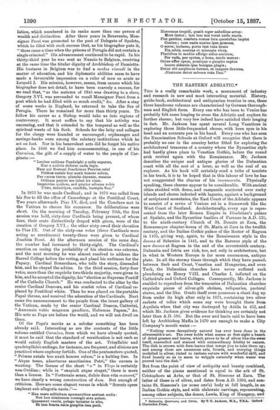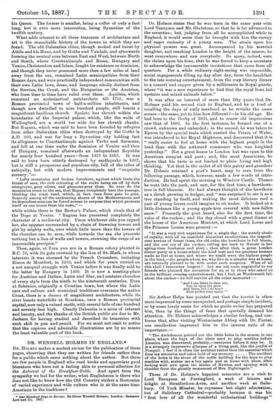THE EASTERN ADRIATIC.*
Tuts is a really remarkable work, a monument of industry and research in new and most interesting material. History, guide-book, architectural and antiquarian treatise in one, these three handsome volumes are characterised by German thorough- ness and English force. Every one who has been to Venice has probably felt some longing to cross the Adriatic and explore its further shores; but very few indeed have satisfied their longing in fact. Mr. Jackson has spent several Long Vacations in exploring those little-frequented shores, with keen eyes in his head and an accurate pen in his hand. Every one who has seen the Examination Schools at Oxford will recognise that there is probably no one in the country better fitted for exploring the architectural treasures of a country where the Byzantine style had hardly given place to Venetian Gothic, before the round arch revived again with the Renaissance. Mr. Jackson describes the unique and antique glories of the Dalmatian coast with all the zest of a lover, as well as the zeal of an explorer. As his book will certainly send a tribe of tourists in his track, it is to be hoped that in this labour of love he has not exaggerated the charms of his innamorata. Physically speaking, these charms appear to be considerable. With ancient cities studded with dome, and campanile scattered over rocky islands and shores indented with lagoons, against a background of sculptured mountains, the East Coast of the Adriatic appears to consist of a series of Venices set in a framework like the West Coast of Scotland. Architecturally, every age is repre- sented from the later Roman Empire in Diocletian's palace at Spoleto, and the Byzantine basilica of Parenzo in A.D. 535, to the ninth-century Church of St. Donato at Zara, the Romanesque chapter-house of St. Maria at Zara in the twelfth century, and the Italian Gothic palace of the Rector of Ragusa in 1435, giving way, again, to the Renaissanoe style in the dooms of Sebenico in 1441, and to the Barocco _style of the new duomo at Ragusa in the end of the seventeenth century. Dalmatia. and Istria are rich, too, not only in architecture, but in what in Western Europe is far more uncommon, antique plate. In all the stormy times through which they have passed, between Serb and Croat, Venetian and Hungarian, and even Turk, the Dalmatian churches have never suffered such plundering as Henry VIII and Charles L inflicted on the Cathedrals and Oxford Colleges. Consequently, Mr. Jackson is enabled to reproduce from the treasuries of Dalmatian churches exquisite pieces of silver-gilt shrines, reliquaries, pastoral staves, and the like. Grads) itself even possesses a ohest dug up from under its high altar only in 1871, containing two silver caskets of relics which some say were brought there from Aquileia when that city was destroyed by Attila in 452, and which Mr. Jackson gives evidence for thinking are certainly not later than A.D. 580. But the ewer and basin said to have been left by Archbishop Maffia in 1470 are enough to make a City Company's month water
"Nothing more deceptively natural has ever been done in the silversmith's art. The ewer holds what seems at first eight a bench of dried grasses and leaves, whioh prove to be of silver like the-ewer itself, enamelled and stained with extraordinary fidelity to nature. The dish is strewn with fern-leaves that tempt you to take them up; and among them are numerons eels, lizards, and creeping things modelled in silver, tinted to imitate nature with wonderful skill, and fixed loosely so as to seem to wriggle naturally when water was poured into the dish."
But from the point of view of antiquity and beauty combined, neither of the pieces mentioned is equal to the ark of St. Gristophoro at Arbe, or that of St. Simeon° at Zara. The latter of these is of silver, and dates from A.D. 1390, and con- tains St. Simeone's (or eome one's) body at full length, in an Italian Gothic style, and with elaborate carvings, representing, among other subjects, the-donor, Lewis, King of Hungary, and • Dalmatia, Quarnoro; and Idris. By T. G. Tadao% BrA.,, MLA. Oxford Okroodon Prem.
his Queen. The former is smaller, being a coffer of only a foot long, but in even more interesting, being Byzantine of the twelfth century.
What adds interest to all these treasures of architecture and art is the remarkable history of the towns in which they are found. The old Dalmatian cities, though sacked and burnt by Attila and his Huns, and by Goths and Vandals, and afterwards forming the neutral zone between East and West, between North and South, where Constantinople and Rome, Hungary and Venice, Christendom and.Islam, fought for existence or dominion, and. though they never possessed more than a few miles of land away from the sea, remained Latin municipalities from their Roman days, and were practically independent communities with their own Latin laws, dress, and language wholly distinct from the Servian, the Croat, and the Hungarian or the Austrian, who from time to time have ruled over them. Aquileia, which remained an ecclesiastical patriarchate till 1751, was a Boman provincial town of half-a-million inhabitants, and though now dwindled to nine hundred people, still boasts a magnificent basilican church. Spalato has shrunk within the boundaries of the Imperial palace, which, like the walls of Wallingford, are a world too wide for her shrunk shanks. But Ragusa, which was said to have been founded by refugees from other Dalmatian cities when destroyed by the Goths in AD. 260, and was for long a Byzantine city holding fast its allegiance to Constantinople against Turks and Saracens, and fell at one time under the dominion of Venice and then of Hungary, remained afterwards an independent Republic for nearly four hundred years—from 1413 to 1816. It was said, to have been utterly destroyed by earthquake in 1667, but is still a prosperous and populous city, full of the relics of antiquity, but with modern improvements and "exquisite scenery t"— " Lofty mountains and broken foreshore, against which beats the bluest of seas, the rich colouring of the rocks being set off by dark evergreens, grey olives, and glaucous-grey aloes. So near do the mountains come to the sea, that Ragusa completely bare the passage, blocking the coast road, which, in fact, rune from gate to gate. Scarcely among all the enchanting shores of the Mediterranean and it dependent seas can be found scenes to surpass that which presents itself as one issues from the town,"—
while within there is the Rector's Palace, which rivals that of the Doge at Venice. " Ragasa has preserved completely the character of a medisaval city. From whichever aide you regard her, she appears surrounded by a chain of frowning towers and girt by mighty walls, over which little more than the towers of the churches can be seen, while towards the sea she presents nothing but a line of walls and towers, crowning the verge of an inaccessible precipice."
Then, again, at Zara you are in a Roman colony planted in B.C. 78, with its gate crowned by the lion of St. Mark, in whose interests it was stormed by the French Crnsaders, including Simon de Montfort, in 1203, and which for years carried on a not unequal struggle with Venice before it was finally sold to the latter by Hungary in 1409. It is now a meeting-place for Austrian and Italian, Latin and Slav, and contains churches of every style from the ninth to the nineteenth centuries. Even at Sebenico, originally a Croatian town, but where the Latin race and culture and municipal traditions overcame the native Croat, there is a duomo of magnificent architecture, while its river boasts waterfalls at Scardona, once a Roman provincial eapitalnow only a ruined castle, with several falls of one hundred and seventy feet high. Clearly Dalmatia is a mine of interest and beauty, and the thanks of the British public are due to Mr. Jackson for having studied and described its treasuries with such skill in pen and pencil. For we must not omit to notice that the copious and admirable illustrations are by no means the least valuable part of the book.



































 Previous page
Previous page